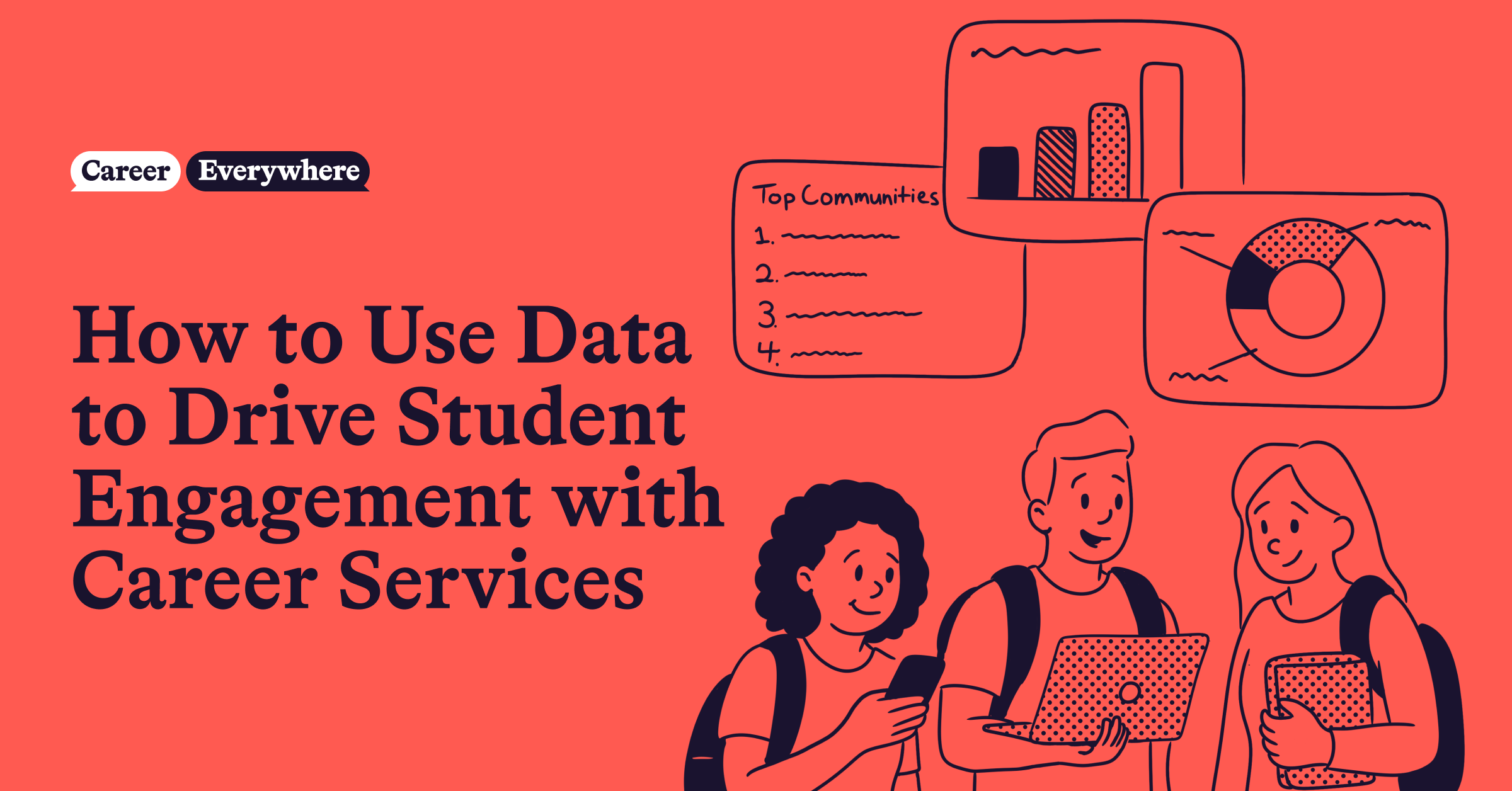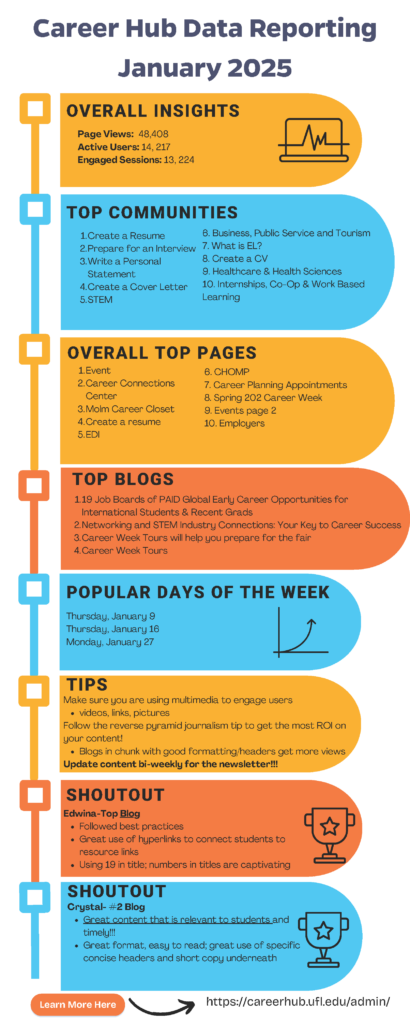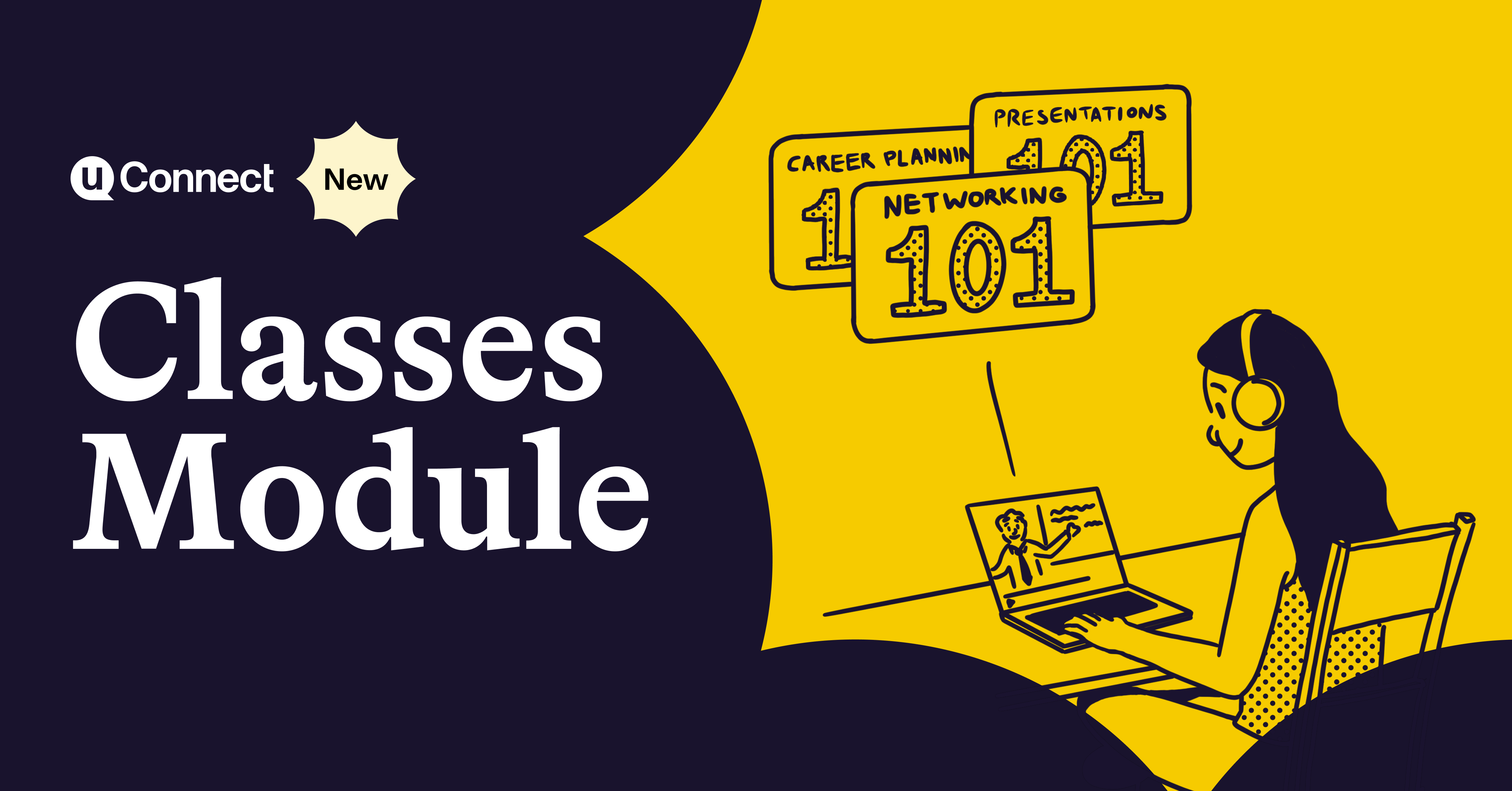
In today’s fast-paced, data-driven world, career services professionals are finding new ways to leverage analytics to better understand and support student engagement.

Julia Vollrath, Senior Associate Director for Integrative Career Solutions at the University of Florida’s Career Connections Center (aka C3), has been at the forefront of this transformation. Through a data-informed approach, Vollrath and her team have successfully optimized career services by identifying engagement trends, refining outreach strategies, and making informed decisions about resource allocation.
We recently sat down with Vollrath to discuss how career services teams can use data to enhance student engagement and improve career readiness outcomes.
Learn more from Vollrath in her episode of the Career Everywhere podcast.
Why data matters in career services
At its core, career services exists to support students in their professional journeys. But understanding how and when students engage with these services can be a big challenge. What resources are students seeking first? How do they navigate from resource to resource, and in what order?
To answer these types of questions, Vollrath emphasizes the importance of using data to paint a clearer picture of student behaviors.
“We don’t just want to know who’s coming in the door,” she said. “We want to know what happens after that first interaction. Does a student return for another appointment? Do they attend a career fair? Do they secure an internship?”
Tracking these data points allows the C3 team to identify trends and gaps in engagement. For example, they can see if first-year students are underutilizing certain career resources or if engagement dips at specific points in the semester. These insights then inform programming decisions, ensuring that services are tailored to student needs.
Identifying gateway services
A key aspect of Vollrath’s approach is identifying “gateway” services—specific interactions that often serve as a student’s first step into career services. Whether it’s a resume review, a career fair, or an employer panel, these initial engagements can act as springboards for deeper involvement.
“We’ve been able to pinpoint the services that act as catalysts for continued engagement,” Vollrath said. “For example, students who attend a career fair in their first year are more likely to come back for an advising appointment later on. That’s a valuable insight because it helps us refine our outreach strategies.”
By focusing on these gateway experiences, career centers can create intentional pathways for students to stay engaged. Rather than relying on one-off interactions, they can build a roadmap that encourages students to take advantage of multiple services over time.
Making data-driven adjustments
One of the most impactful ways data is used in the C3 is in making real-time adjustments to services and programming. Vollrath and her team regularly review engagement metrics to assess the effectiveness of events, workshops, and other career resources.
“Last year, we noticed a drop in attendance for some of our early morning workshops,” she said. “By looking at the data, we saw that students were more likely to attend sessions later in the day. So we shifted some of our key programming to afternoons and evenings, and attendance immediately improved.”
This kind of agile, data-informed decision-making ensures that career centers are continuously evolving to meet student needs and increase equitable access.
Communicating data insights across campus
As any career services professional knows, a significant challenge in higher education is making sure that different departments are aligned in their efforts to support students. Vollrath stresses the importance of not just collecting data, but also sharing it effectively with campus partners and telling a compelling story.

“It’s not just about what we do in career services,” she said. “It’s about how we communicate our findings to academic advisors, faculty, and other student support teams. When we all have a shared understanding of student engagement trends, we can work together to create a more seamless support system.”
For example, if data shows that business students are engaging with career services at a much higher rate than engineering students, that information can be shared with faculty in the engineering department. Together, they can develop targeted outreach strategies to ensure those students aren’t missing out on valuable career resources.
Vollrath’s team also works hard to share the data amongst career center staff, often pulling together monthly reports, like the one to the right. This report was created by Vollrath’s colleague Marissa Altenburg, the Integrative Solutions Career Manager, who shared this example in the Career Everywhere Community. According to Altenburg, she used a Canva template she created to share overall insights, top 10 communities, top 10 overall pages, top three to five blogs, popular days of the week, monthly tips, and monthly shoutouts to her colleagues who are doing innovative things that follow best practices.
Altenburg added, “Additionally, I try to include links to the shoutouts so they have the examples easily accessible to them. I share this in our office’s Microsoft Teams channel, with bullet points that summarize the visual data report.”
Leveraging technology for expanded (and more equitable) access
Technology has played a significant role in expanding the reach of career services, particularly in making resources more accessible for students with busy schedules. At the University of Florida, the C3 team has implemented a virtual career center (powered by uConnect) that offers 24/7 access to career resources, online appointments, and virtual workshops.
“Not every student can make it to an in-person career fair or advising session,” Vollrath said. “By offering virtual options, we’re able to meet students where they are—whether that’s in their dorm room, at an internship, or even studying abroad.”
This hybrid approach has proven particularly effective in increasing engagement among non-traditional students, such as part-time learners and those balancing work and school commitments.
And because the University of Florida uses uConnect’s virtual career center platform, Vollrath’s team has constant access to helpful engagement and usage data through the platform’s back end. She can see:
- How many total page views their virtual career center received
- How many views individual pieces of content received
- Most visited communities
- Most popular pages
- Top blogs
- When their virtual career center gets the most web traffic
- And more
As we noted above, having consistent access to this kind of data allows Vollrath and her team to make informed decisions about programming, online resources, student outreach, and more.
The future of data in career services

Looking ahead, Vollrath sees even more opportunities for data to shape the future of career services. She envisions a future where predictive analytics can help identify at-risk students who may need additional career support before they even realize it themselves.
“What if we could use data to proactively reach out to students who haven’t engaged with career services at all?” she said. “Instead of waiting for them to come to us, we could step in and offer guidance at the right moment.”
By continually refining data collection and analysis techniques, career centers can move from reactive to proactive engagement strategies, ensuring that no student falls through the cracks.
Conclusion
For career services professionals looking to enhance student engagement, Vollrath’s advice is clear: Start with the data.
“Even if you don’t have sophisticated analytics tools, you can start by looking at simple metrics—attendance numbers, appointment bookings, survey responses,” she said. “Over time, you’ll start to see patterns that can help you refine your approach.”
By embracing a data-driven mindset, career centers can make sure their services are not only effective but also responsive to the ever-changing needs of students. In the end, the goal remains the same: Helping students take meaningful steps toward their careers with confidence and clarity.
Learn more from Vollrath in her episode of the Career Everywhere podcast.

